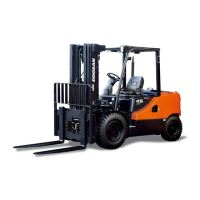D439E Service Manual 2. Engine Mechanical System (D439E)
32
Adjustment
Compression Pressure
1. Before performing on-vehicle inspection, check to
see whether engine oil, starter motor and battery
are in normal condition.
2. Start the engine and warm up until the coolant
temperature reaches 80~90℃
3. Stop the engine and remove the ECM fuse.
4. Remove all injectors from cylinder head.
CAUTION
Be careful that foreign materials do not intrude
through the injector installation hole.
5. Crank the engine to remove the foreign materials
from cylinders.
6. Install compression gauge adaptor (09353-45100)
together with gasket and then, connect the
compression gauge.
7. Crank the engine and measure the compression
pressure.
CAUTION
a. Take care that fuel is not injected.
b. Since compression pressure varies
depending on the engine speed, be careful in
measuring.
c. Since worn amounts of each cylinder are
different, measure the pressure at all cylinders.
8. Measure the compression pressure of all
cylinders to see if all compression pressures are
within the limit.
Items
Standar
d
Limit
Corre
ctive
action
Each
cylinder
26kg/cm
2
20kg/cm
2
Check
Compress
ion
pressure
(200rpm)
Difference
between
cylinders
- 4kg/cm
2
Check
9. If the compression pressure difference of any
cylinder exceeds the limit, fill some engine oil
through injector hole and measure the
compression pressure of the cylinder again.
1) If the compression pressure increases, it
indicates that the piston, piston, piston ring or
cylinder wall is worn or damaged.
2) If the compression pressure does not increase,
it indicates that valve is stuck, valve contact is
poor or pressure is leaking through the cylinder
head gasket.

